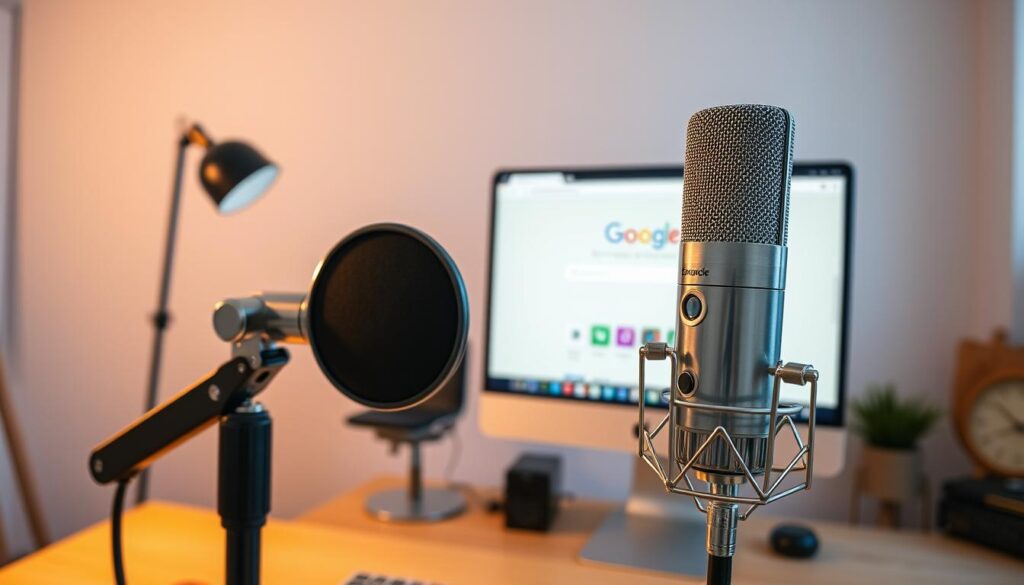Imagine finding answers, directions, or your favorite playlist without lifting a finger. Modern tools let you access information instantly by speaking naturally. This approach blends convenience with cutting-edge technology, transforming how we interact with our devices.
To get started, simply tap the microphone icon in the Google app and say “OK Google.” This activates a hands-free experience, perfect for multitasking or when typing isn’t practical. Whether you’re cooking, driving, or relaxing, spoken commands help you find music, movies, or nearby restaurants effortlessly.
Features like automatic voice recognition and microphone permissions ensure smooth operation. You’ll spend less time typing and more time enjoying results tailored to your needs. Best of all, this method integrates seamlessly into daily routines, making it ideal for busy lifestyles.
In this guide, we’ll explore setup tips, practical uses, and advanced tricks to enhance your experience. By the end, you’ll master this tool and discover how it simplifies everyday tasks.
Key Takeaways
- Activate hands-free queries using the “OK Google” command
- Easily locate information without manual typing
- Optimize permissions for seamless microphone access
- Streamline activities like navigation or entertainment
- Learn step-by-step methods to maximize efficiency
Understanding Voice Search on Chrome
Ever wished you could multitask without pausing to type on your phone? Modern technology now lets you interact with the internet through natural conversation. This shift transforms how people access information, blending speed with intuitive responses.
Redefining Digital Interactions
Speaking commands instead of typing eliminates friction in daily tasks. Need dinner ideas while chopping vegetables? Ask for recipes aloud. Running late to a meeting? Request traffic updates mid-stride. These scenarios highlight how spoken requests save time and keep you focused on the moment.
Everyday Applications Made Simple
Popular queries include checking flight statuses, finding weekend events, or getting quick translations. Try phrases like “Where’s the nearest pharmacy?” or “Play jazz playlists.” The system even handles niche requests, like “How many tablespoons in a cup?” during baking sessions.
This method shines in accessibility too. Those with mobility challenges or visual impairments benefit from voice-first navigation. With updates improving accuracy yearly, the tool adapts to accents and background noise better than ever.
Voice Search Chrome Setup Guide
Getting started with hands-free browsing is easier than you think. Just a few quick adjustments transform your device into a responsive helper ready for spoken commands. This setup works across computers, tablets, and phones, letting you ask questions or play media without typing.

Installation and Basic Activation
First, download the browser from Google’s official site if you haven’t already. Installation takes seconds—follow the prompts, then launch it. Visit google.com to find the microphone icon in the search bar. Click it once to activate the feature.
Permissions and Customization
Granting access to your microphone ensures smooth operation. On Windows or Mac, check browser settings under Privacy. For Android devices, enable permissions in the app’s settings menu. iPhones require approving access through Safari or the Google app.
To use voice commands anytime, turn on OK Google detection. Open your device’s settings, navigate to voice match, and follow the setup steps. This lets you start queries even when your screen is off—perfect for quick requests while driving or cooking.
Tips, Best Practices, and Troubleshooting for Voice Search
Struggling with misunderstood commands? Fine-tuning your approach can make all the difference. Whether you’re asking for directions or checking the weather, these strategies help you get precise results faster.
Enhancing Accuracy with Voice Search Techniques
Small adjustments dramatically improve how well your device understands you. For example, saying “nearest coffee shop open now” works better than vague phrases like “find coffee.” Here’s a quick reference:
| Technique | Impact |
|---|---|
| Speak at a steady pace | Reduces garbled interpretations |
| Use specific keywords | Narrows results effectively |
| Position mic 6-12 inches away | Minimizes background noise |
“Clarity and context are key. Think of your device as a conversation partner—it needs to hear you properly to respond accurately.”
Solving Common Voice Search Issues
If requests fail, start by testing your microphone in the Google app settings. Background apps like music players can interfere—close them first. For persistent errors:
- Restart your device to refresh connections
- Retrain voice models under Voice Match
- Update your browser for compatibility fixes
Still stuck? Check permissions in system settings. Over 60% of glitches stem from blocked mic access. A quick toggle often solves it!
Conclusion
Ready to let your words do the work? Hands-free browsing simplifies daily tasks, from checking recipes to finding quick answers. Enabling this feature takes minutes: install the Google app, tap the microphone icon, and grant permissions. Once set up, your phone or desktop becomes a responsive helper.
Remember to speak clearly and review settings if queries misfire. Following best practices saves time and sharpens accuracy. Experiment with phrases like “What’s the weather?” or “Directions to downtown”—the system adapts to your needs.
These steps work whether you’re on a laptop or open Google on mobile. Give it a try today! A quick “OK Google” unlocks faster results, letting you focus on what matters most. Your next discovery is just a sentence away.
